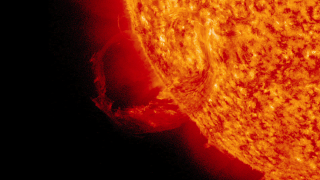

| Visitors Now: | |
| Total Visits: | |
| Total Stories: |

| Story Views | |
| Now: | |
| Last Hour: | |
| Last 24 Hours: | |
| Total: | |
Huge Coronal Mass Ejection Erupts From the Sun Today, Jan 31, 2013
 On Jan. 31, 2013 at 2:09am EST, the sun erupted with an Earth-directed coronal mass ejection or CME. Experimental NASA research models, based on observations from the Solar Terrestrial Relations Observatory (STEREO) and ESA/NASA’s Solar and Heliospheric Observatory, show that the CME left the sun at speeds of around 575 miles per second, which is a fairly typical speed for CMEs. Historically, CMEs at this speed are mild.
On Jan. 31, 2013 at 2:09am EST, the sun erupted with an Earth-directed coronal mass ejection or CME. Experimental NASA research models, based on observations from the Solar Terrestrial Relations Observatory (STEREO) and ESA/NASA’s Solar and Heliospheric Observatory, show that the CME left the sun at speeds of around 575 miles per second, which is a fairly typical speed for CMEs. Historically, CMEs at this speed are mild.
Not to be confused with a solar flare, a CME is a solar phenomenon that can send solar particles into space and reach Earth one to three days later.
Earth-directed CMEs can cause a space weather phenomenon called a geomagnetic storm, which occurs when they connect with the outside of the Earth’s magnetic envelope, the magnetosphere, for an extended period of time. In the past, CME’s such as this have caused auroras near the poles but didn’t disrupt electrical systems on Earth or interfere with GPS or satellite-based communications systems.
NOAA’s Space Weather Prediction Center (http://swpc.noaa.gov) is the United States Government official source for space weather forecasts, alerts, watches and warnings.
Updates will be provided if needed.
|
A coronal mass ejection (CME) on Jan. 31, 2013 was accompanied by a large prominence eruption best visible in light with a wavelength of 304 angstroms. NASA’s Solar Dynamics Observatory captured this footage from 10 p.m. EST on Jan. 30, 2013, to 4 a.m. the next morning. Credit: NASA/SDO/Goddard Space Flight Center
|
High Resolution imagery and additional multimedia from this event is available athttp://svs.gsfc.nasa.gov/vis/a010000/a011200/a011201/.
2013-01-31 19:49:48
Source: http://www.educatinghumanity.com/2013/01/huge-coronal-mass-ejection-erupts-from.html
Source:


